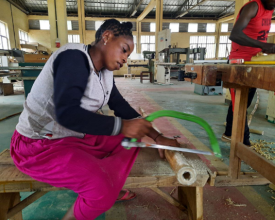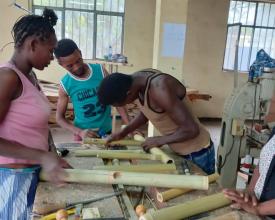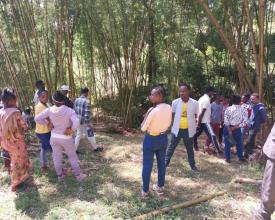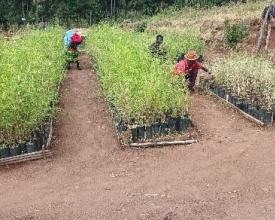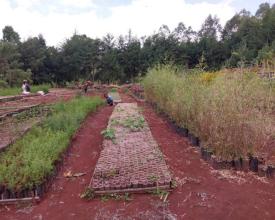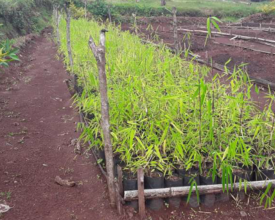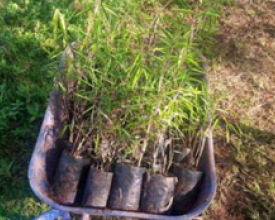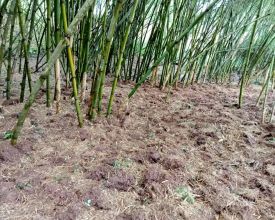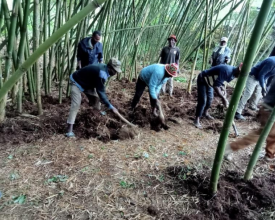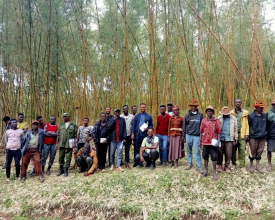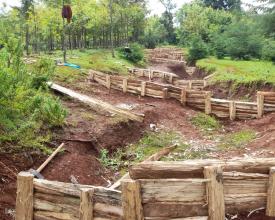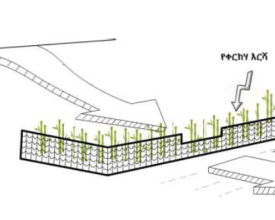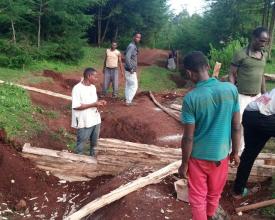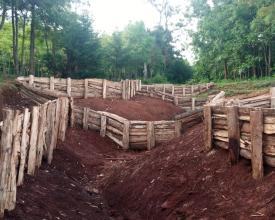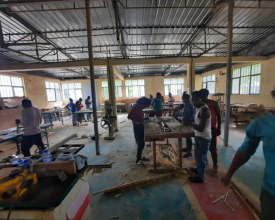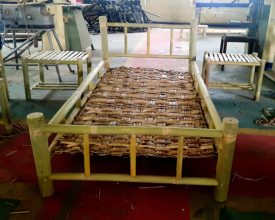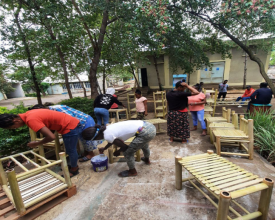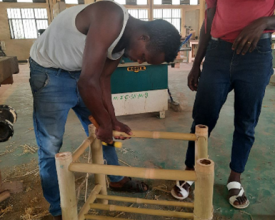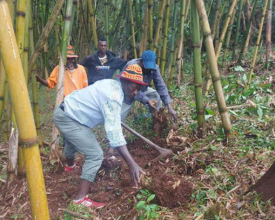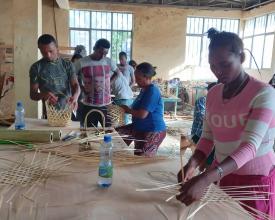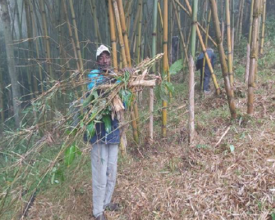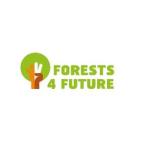
La croissance verte grâce au bambou : Renforcer les communautés pour une résilience économique et environnementale

La dégradation des sols est un problème pressant en Éthiopie, qui affecte plus de 85 % de ses terres à des degrés divers. Le bambou apparaît comme un outil crucial pour la restauration des terres en raison de sa résilience dans les environnements difficiles, de son système racinaire qui prévient l'érosion et de sa croissance rapide. Son potentiel économique est également important, avec des cycles de croissance rapides et diverses applications de produits. Le projet mondial Forests4Future (F4F), lancé par la Deutsche Gesellschaft für Internationale Zusammenarbeit (GIZ), se concentre sur le développement d'un système de production et de gestion durable du bambou. Ce projet vise à réhabiliter et à restaurer les paysages de la région du sud de l'Éthiopie (bassins versants des lacs Abaya et Chamo), gravement touchés par l'érosion et la sédimentation, tout en stimulant la croissance économique des communautés concernées. Les premiers résultats indiquent des progrès prometteurs dans les efforts de restauration et de revitalisation économique, démontrant le potentiel des initiatives basées sur le bambou pour la gestion durable des terres et le développement économique des communautés en Éthiopie.
Contexte
Défis à relever
Défis environnementaux :
- Dégradation des sols : lutte contre l'érosion et pratiques foncières durables.
- Perte de biodiversité : atténuer la perte de biodiversité en restaurant les habitats dégradés.
- Changement climatique : séquestrer le carbone et atténuer le changement climatique.
- Qualité de l'eau : améliorer la régulation de l'écoulement des eaux de surface et réduire l'érosion des sols et les niveaux de sédimentation.
Défis sociaux :
- Sécurité des moyens de subsistance : assurer la stabilité grâce à des activités économiques durables.
- Création d'emplois : créer des opportunités d'emploi, en particulier pour les groupes marginalisés.
- Renforcement des capacités : améliorer les compétences communautaires pour un développement durable.
Défis économiques :
- Disparités de revenus : Promouvoir les revenus et les conditions de vie des femmes et des jeunes grâce à la propagation et à la transformation du bambou.
- Diversification économique : introduction d'entreprises durables pour la croissance.
- Accès au marché : faciliter l'accès aux marchés pour les produits locaux, en particulier les produits en bambou à valeur ajoutée, afin d'améliorer la viabilité économique et la compétitivité.
Emplacement
Traiter
Résumé du processus
La synergie entre les cinq éléments du projet Forests4Future crée une approche holistique de la gestion durable du bambou et du développement communautaire. Chaque élément complète et soutient les autres, formant un système intégré qui maximise les impacts et les résultats positifs.
- Le Building Block 1 alimente le Building Block 2 en fournissant des plants pour l'établissement de plantations, tandis que le Building Block 2 fournit du bambou brut aux Building Blocks 3 et 4 pour la construction et la transformation.
- Le bloc 3 complète le bloc 2 en fournissant des mesures de restauration des ravines et de protection des sols contre l'érosion dans les plantations de bambou, contribuant ainsi aux efforts de restauration des terres.
- Le bloc 4 ajoute de la valeur aux produits du bambou récoltés dans les plantations, créant ainsi des biens commercialisables qui contribuent à la croissance économique et à la durabilité.
- Le bloc 5 soutient tous les autres blocs en proposant des programmes de formation essentiels qui améliorent les compétences, les connaissances et les capacités tout au long de la chaîne de valeur du bambou.
Blocs de construction
Production de plants de bambou
L'objectif de ce module est de présenter la création réussie de pépinières de bambous par l'initiative Forests4Future dans sa zone d'intervention. Ces pépinières jouent un rôle crucial dans l'économie locale en vendant de jeunes plants de bambou afin de générer des revenus pour la communauté. Ces plants sont principalement utilisés pour créer des plantations de bambou, contribuant ainsi à la réhabilitation des terres dégradées dans le bassin versant. Forests4Future se concentre spécifiquement sur le travail avec des espèces de bambou indigènes, par exemple le bambou des hauts plateaux éthiopiens(Yushania alpina k.), en tirant parti de leur croissance rapide et de leur capacité à absorber les gaz à effet de serre en tant qu'outil efficace de séquestration du carbone, s'alignant ainsi sur les objectifs climatiques mondiaux. En outre, l'établissement de plantations de bambous contribue non seulement à la restauration des terres, mais fournit également une source durable de matières premières pour diverses industries, améliorant ainsi les opportunités économiques dans la région.
Facteurs favorables
- Engagement de la communauté: L'implication de la communauté locale est cruciale pour une exploitation durable des pépinières de bambous.
- Expertise technique: L'accès aux connaissances et à l'expertise en matière de culture du bambou et de gestion des pépinières garantit une croissance et une productivité saines.
- Accès au marché: Des liens solides avec le marché pour la vente des produits du bambou sont nécessaires pour générer des revenus et assurer la durabilité.
- Soutien politique: Des politiques favorables promouvant une sylviculture durable et soutenant les PME favorisent la viabilité à long terme des pépinières de bambou.
Leçon apprise
- Appropriation par la communauté : L'implication des communautés locales dans les processus de prise de décision et la garantie qu'elles ont un intérêt dans la réussite du projet favorisent un sentiment d'appropriation et d'engagement.
- Renforcement des capacités : La formation continue et les programmes de renforcement des capacités des exploitants de pépinières et des cultivateurs de bambou sont essentiels pour améliorer la productivité et les normes de qualité.
- Diversification des marchés : L'exploration de diverses opportunités de marché au-delà des ventes locales, telles que les marchés d'exportation ou les produits à valeur ajoutée, peut améliorer les flux de revenus et la résilience du marché.
Création et restauration de plantations de bambous
Le Building Block 2 de Forests4Future se concentre sur le soutien aux communautés pour établir des plantations de bambous dans les terres communales dégradées et les ravines d'érosion. Les plants pour les plantations proviennent de pépinières locales, comme détaillé dans le Building Block 1. Lorsque le bambou atteint un certain stade de croissance, il peut être récolté et vendu à des unités de traitement du bambou (UP) locales, qui transforment alors la matière première en produits de valeur, comme indiqué dans le module 4. Cette approche favorise non seulement la création de revenus durables pour la communauté, mais contribue également à la restauration des terres dégradées. La capacité du bambou à protéger les sols joue un rôle crucial dans les efforts de restauration à long terme, en particulier dans les zones vulnérables à l'érosion ou déjà fortement dégradées, comme les bassins versants des lacs Abaya et Chamo. L'érosion et la sédimentation constituent des menaces importantes pour les agriculteurs et les pêcheurs locaux, ce qui rend les efforts de restauration avec le bambou essentiels pour protéger les sols et garantir des opportunités de revenus futurs pour les communautés.
Facteurs favorables
- Engagement communautaire: Sensibilisation et soutien local aux plantations de bambou.
- Assistance technique: Expertise essentielle dans la culture et la gestion du bambou.
- Accès au marché: Mise en place de chaînes de valeur solides permettant de tirer des revenus réguliers des produits du bambou.
- Soutien politique: Politiques favorables à une sylviculture durable et à la génération de revenus.
Leçon apprise
- Choix du site : Une attention particulière aux conditions du site, telles que le type de sol, la disponibilité de l'eau et la pente, est cruciale pour la réussite de l'établissement d'une bambouseraie.
- Sélection des espèces : Le choix d'espèces de bambou adaptées aux conditions climatiques et pédologiques locales est important pour obtenir une croissance et une productivité optimales.
- Formation et renforcement des capacités : Les programmes de formation continue et de renforcement des capacités destinés aux agriculteurs et aux travailleurs des plantations sont essentiels pour améliorer les compétences et les connaissances en matière de culture et de gestion du bambou.
- Droits d'utilisation des terres: Il est essentiel de garantir les droits d'utilisation des terres pour assurer la durabilité et la gestion efficace des ressources dans la zone restaurée.
- Suivi et évaluation : Le suivi et l'évaluation réguliers des performances de la plantation, y compris les taux de croissance, le rendement et les impacts environnementaux, sont nécessaires pour prendre des décisions de gestion éclairées et optimiser les résultats (dans le cadre des activités de gestion post-plantation).
Le bambou comme principal intrant pour la réhabilitation des ravines
Le bloc 3 traite de l'utilisation de matières premières et de produits en bambou pour la réhabilitation des ravines, en intégrant le concept éco-hydrologique mis en œuvre par Forests4Future. Cette mesure de protection contre l'érosion, peu coûteuse, a été testée et développée avec succès. Outre la vente de la matière première de bambou à des unités de transformation locales (PU) comme décrit dans le Building Block 2, elle peut également être utilisée pour construire des mesures de restauration des ravines. Ces infrastructures consistent en une série de barrières semi-perméables en bois placées dans les ravines d'érosion en tenant compte de la direction et de l'intensité du flux d'eau, formant un système de régulation du ruissellement de surface qui contrôle de manière séquentielle le flux d'eau de surface. Cette unité joue un rôle crucial dans la régulation des paramètres hydrologiques clés tels que la concentration et la vitesse du flux, qui à leur tour régulent les processus hydrologiques et biologiques tels que le ruissellement et l'infiltration. En atténuant l'érosion dans les ravines, ces mesures contribuent aux efforts de restauration à long terme des ravines. Cette technique et les compétences requises peuvent être facilement reproduites par d'autres agriculteurs en raison de sa méthode de construction relativement simple, ce qui la rend accessible pour une adoption à grande échelle.
Facteurs favorables
- Expertise technique : L'accès à l'expertise en éco-hydrologie, en contrôle de l'érosion et en construction de bambous est crucial pour l'efficacité des projets éco-hydrologiques.
- Engagement de la communauté : L'implication des communautés locales dans la planification du projet favorise l'appropriation et la durabilité.
- Disponibilité des ressources : Des ressources adéquates en bambou et autres sont essentielles pour la mise en œuvre du projet.
- Suivi et évaluation : Des mécanismes d'évaluation solides garantissent l'efficacité des mesures et permettent des ajustements en vue d'une réussite à long terme.
Leçon apprise
- Choix du site : La sélection minutieuse du site (c'est-à-dire du ravin) en tenant compte de facteurs tels que la pente, le type de sol et la couverture végétale est cruciale pour l'efficacité des mesures éco-hydrologiques.
- Considérations relatives à la conception : Une conception appropriée des barrières en bois et des structures de contrôle des flux d'eau, basée sur les conditions spécifiques du site et la modélisation hydrologique, améliore la performance des mesures éco-hydrologiques.
- Maintenance et entretien : La maintenance et l'entretien réguliers de l'infrastructure écohydrologique, y compris la réparation des barrières endommagées et l'élimination de l'accumulation de sédiments, sont nécessaires pour garantir une efficacité continue.
- Participation de la communauté : La participation des communautés locales à la planification et à la mise en œuvre des projets, ainsi qu'aux activités de surveillance et d'entretien, permet d'accroître la sensibilisation et d'assurer la durabilité des projets éco-hydrologiques.
- Gestion adaptative : La mise en œuvre de stratégies de gestion adaptative basées sur les données de suivi et le retour d'information des parties prenantes locales permet de relever les défis et d'améliorer les résultats du projet au fil du temps.
Unités de transformation à valeur ajoutée du bambou local
Le bloc de construction 4 se concentre sur la création et le soutien de petites et moyennes entreprises (PME) de transformation du bambou par Forests4Future dans la zone d'intervention. L'objectif principal de l'établissement de ces entreprises est de créer des opportunités commerciales associées qui se concentrent sur la génération de revenus durables et la création d'emplois pour la communauté locale. La matière première du bambou provient principalement des agriculteurs locaux de la région, y compris ceux soutenus par le projet comme détaillé dans le Building Block 2. Ces unités transforment le bambou brut en produits de valeur, en particulier des meubles tels que des chaises, des tables, des lits, des étagères et divers articles de cuisine. Le traitement conservateur du bambou contre les insectes, qui garantit la durabilité et la qualité des produits, est un facteur de réussite important. En outre, les produits en bambou sont abordables pour l'ensemble de la communauté, ce qui rend accessibles des articles tels que les lits en bois, qui seraient autrement coûteux. Cette accessibilité financière présente des avantages évidents pour la population locale. En outre, le bambou sert d'alternative ou de substitut au bois, réduisant ainsi la pression sur les forêts naturelles de la région. En encourageant l'utilisation du bambou comme ressource durable, les unités de transformation du bambou contribuent à la conservation de l'environnement et à l'efficacité de l'utilisation des ressources.
Facteurs favorables
- Expertise technique : L'accès aux compétences en matière de traitement du bambou, de conception des produits et de contrôle de la qualité est essentiel pour obtenir des produits de haute qualité.
- Accès au marché : Le développement de canaux de distribution solides est essentiel pour les ventes et l'accès à la clientèle.
- Gestion de la chaîne d'approvisionnement : Une logistique et un contrôle des stocks efficaces garantissent le bon déroulement des opérations.
- Soutien financier : Un financement adéquat est nécessaire pour créer et développer des unités de transformation.
- Facilité d'adoption : Contrairement à la transformation du bois, les techniques du bambou sont plus simples et nécessitent moins de ressources, ce qui les rend accessibles aux communautés locales.
Leçon apprise
- Diversification des produits : La diversification de l'offre de produits au-delà du mobilier, comme les revêtements de sol ou les matériaux de construction, peut élargir les débouchés et les sources de revenus.
- Contrôle de la qualité : La mise en œuvre de mesures rigoureuses de contrôle de la qualité tout au long du processus de production est essentielle pour maintenir les normes des produits et la satisfaction des clients.
- Partenariats et collaboration : La collaboration avec des artisans, des concepteurs et des experts locaux peut améliorer l'innovation des produits, le positionnement sur le marché et la compétitivité.
- Études de marché : La réalisation d'études de marché approfondies et l'analyse des réactions des clients permettent de comprendre les tendances du marché, les préférences des consommateurs et la demande de produits, ce qui oriente la stratégie de l'entreprise et le développement des produits.
- Liens avec le marché : Le maintien de liens solides avec le marché et les canaux de distribution est essentiel pour maintenir la présence sur le marché et garantir la livraison des produits aux clients dans les délais impartis. S'engager régulièrement avec les acteurs du marché et s'adapter aux changements du marché peut aider à maintenir la compétitivité et à répondre aux attentes des clients.
- Récolte durable: La récolte durable du bambou contribue positivement au développement de la base de ressources.
Formation et renforcement des capacités dans le domaine du bambou
Le Building Block 5 se concentre sur l'offre de diverses formations sur le bambou par Forests4Future pour soutenir les différents aspects de la chaîne de valeur du bambou dans leur zone d'intervention. Ces formations sont essentielles en tant que facteurs de réussite et de durabilité des activités liées au bambou entreprises par le projet. Forests4Future fournit une assistance financière et technique pour l'organisation et la mise en œuvre de ces formations. Depuis le début du projet, Forests4Future a organisé de nombreuses formations sur le bambou adaptées à des besoins spécifiques, par exemple :
- Propagation du bambou : des formations sur la propagation du bambou sont dispensées aux pépinières afin d'assurer la réussite de la propagation des semis de bambou pour l'établissement des plantations.
- Gestion et récolte des plantations et peuplements de bambous : ces formations couvrent divers aspects de la gestion des plantations de bambous, notamment les techniques de plantation, les pratiques d'entretien, la gestion des parasites et des maladies, et les méthodes de récolte durable.
- Traitement de préservation du bambou : cette formation est essentielle pour les unités de transformation du bambou afin d'apprendre les techniques appropriées pour traiter le bambou avec des produits chimiques, de l'eau chaude et de l'eau froide, ainsi que pour tenir compte du moment de la récolte afin de réduire la sensibilité des chaumes de bambou aux insectes.
(...)
En offrant ces diverses formations, Forests4Future vise à renforcer les capacités et les compétences des acteurs locaux impliqués dans la chaîne de valeur du bambou. Cela contribue à améliorer la productivité, la qualité des produits et la durabilité globale des activités liées au bambou. De plus, ces formations permettent aux communautés locales de participer activement et de bénéficier des avantages économiques et environnementaux du bambou.
Facteurs favorables
- Ressources de formation : L'accès à des formateurs qualifiés, à du matériel et à des installations est essentiel pour que les formations sur le bambou soient efficaces.
- Engagement de la communauté : L'implication des acteurs locaux améliore les résultats de l'apprentissage et l'appropriation des compétences.
- Apprentissage continu : Les sessions de suivi et les réseaux de pairs renforcent l'impact de la formation.
- Adaptation locale : L'adaptation du contenu aux besoins locaux améliore l'efficacité de la formation.
- Suivi : L'évaluation régulière et le retour d'information des participants permettent d'améliorer le programme.
Leçon apprise
- Programmes de formation sur mesure : La conception de programmes de formation adaptés aux besoins spécifiques et aux niveaux de compétence des participants améliore les résultats de l'apprentissage et l'application pratique des connaissances.
- Formation pratique : L'intégration d'exercices pratiques et de démonstrations dans les sessions de formation améliore l'engagement et la rétention de l'apprentissage.
- Autonomisation des communautés : Permettre aux communautés locales de s'approprier les initiatives de formation et de devenir elles-mêmes des formateurs favorise la durabilité et l'extensibilité des efforts de renforcement des capacités.
- Partenariats et collaboration : La collaboration avec les institutions, les organisations et les experts locaux dans les domaines liés au bambou améliore la qualité et la portée des programmes de formation.
- Mécanismes de retour d'information : La mise en place de mécanismes efficaces de retour d'information, tels que des enquêtes, des groupes de discussion et des formulaires d'évaluation, permet d'améliorer en permanence le contenu de la formation, les méthodes d'enseignement et l'impact global.
Impacts
Impacts sur l'environnement :
- Le bambou contrôle efficacement l'érosion des sols, empêchant la sédimentation dans les plans d'eau et améliorant la santé des sols.
- Les plantations de bambous contribuent de manière significative à la séquestration du carbone, à l'atténuation des émissions de gaz à effet de serre et à la résilience climatique.
- Le bambou aide à restaurer les terres dégradées, à améliorer la résilience des écosystèmes et à promouvoir l'utilisation durable des terres.
- Les plants de bambou favorisent la biodiversité en fournissant des habitats à diverses espèces dans les zones d'intervention.
Impacts sociaux :
- La formation à la transformation du bambou permet aux communautés d'acquérir des compétences et des connaissances, ce qui améliore les moyens de subsistance et les opportunités économiques.
- La mise en place d'industries du bambou crée des emplois, en particulier pour les petits exploitants agricoles et les femmes entrepreneurs.
- Les programmes de formation à la propagation et à la transformation du bambou renforcent les capacités et favorisent l'autonomie et l'esprit d'entreprise.
Impacts économiques :
- Les activités liées au bambou génèrent des flux de revenus durables, réduisant la dépendance à l'égard des moyens de subsistance traditionnels.
- La production de produits en bambou de haute qualité stimule le développement du marché, attirant des acheteurs locaux et internationaux.
- La valeur ajoutée apportée par les unités de transformation du bambou augmente la valeur marchande, ce qui se traduit par une rentabilité et une compétitivité accrues.
Bénéficiaires
- Les petits exploitants agricoles et les propriétaires terriens, qui bénéficient de moyens de subsistance durables et d'une meilleure gestion des terres.
- Les communautés locales, qui bénéficient d'une augmentation des revenus, de l'emploi et de la diversification économique.
- Les femmes entrepreneurs et les groupes marginalisés, qui bénéficient d'un soutien et d'une formation.
Objectifs de développement durable
Histoire
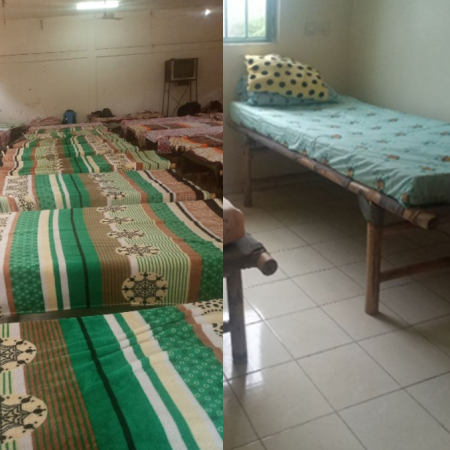
Addis Tesfa et Birhan Chora sont de petites entreprises locales de transformation du bambou soutenues par le projet Forests4Future en Éthiopie. Ces unités sont situées dans le paysage d'intervention du projet du lac Chamo, dans la région du sud de l'Éthiopie. Elles ont été créées en 2020, chacune avec six jeunes, et produisent divers produits en bambou, tels que des meubles.
Pour le démarrage initial, Forests4Future a fourni une formation technique pratique aux jeunes et des outils électriques pour la transformation du bambou. En outre, le gouvernement local a mis en place des hangars de travail et a arrangé un prêt. Par conséquent, les jeunes ont commencé à produire et à introduire de nouveaux produits en bambou en fonction de la demande de la communauté, soutenant ainsi leurs moyens de subsistance.
En 2020, lors de l'épidémie de COVID-19, l'initiative spéciale de la GIZ sur la formation et la création d'emplois (SI Jobs) a eu l'idée novatrice de soutenir la fabrication de lits cliniques en bambou en raison de leur rareté en Éthiopie. SI Jobs, en collaboration avec Forests4Future, a apporté le soutien technique et financier nécessaire aux entreprises de bambou. Celles-ci ont ainsi produit un nombre important de lits en bambou pour les cliniques et ont obtenu un contrat de haut niveau pour la fabrication de 2 000 lits pour les bureaux régionaux de la santé. Ces lits ont ensuite été distribués aux hôpitaux et aux cliniques de la région. Le chiffre d'affaires des entreprises a été multiplié par 6,5 par rapport à leur capital initial. Il s'agit d'une situation gagnant-gagnant pour le secteur de la santé en Éthiopie et pour les unités locales de transformation du bambou.
Grâce à ces bénéfices, les entreprises ont pu accroître leur production et acheter de nouvelles machines et d'autres outils de transformation du bambou.

